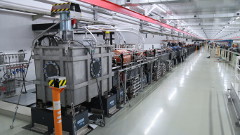 The SCSS accelerator in its new home in the SACLA undulator hall
The SCSS accelerator in its new home in the SACLA undulator hall
At the SPring-8 facility in Harima, an experimental piece of equipment has made a comeback, returning as the centerpiece of a new upgraded beamline of the SACLA x-ray free electron laser. Previously, SACLA had three beamlines, two providing hard x-rays and the third soft x-rays. Though soft x-rays are useful in certain applications, it is the powerful hard x-ray beams that were most revolutionary, so they ended up receiving the most use. Because the hard and soft x-ray beams could not be produced at the same time, and because the soft x-ray beamline did not produce laser light, what this meant in practice was that the soft x-ray beamline was often off-line. And yet, there were users who wanted the opportunity to use an intense soft x-ray laser.
The key to solving this dilemma was an older piece of equipment, the SCSS, which with a length of 60 meters, was actually the prototype of the 700-meter-long SACLA laser. It had been retired in 2013 following SACLA’s opening for public use in 2012, but was given a new mission as the core of the upgrade of the existing beamline to produce soft x-ray laser light. The new device, which was relocated from the original tunnel to the SACLA undulator hall, accelerates electrons independently of SACLA’s operation, and passes them through its own undulators—magnets that change the path of the electrons, making them emit a sharp beam of light as they do. Now, with the upgraded beamline, SACLA has become the only place in the world where both hard and soft x-ray laser can be produced simultaneously at a single facility.
X-ray lasers are important tools for analyzing proteins and other small substances, and soft x-ray lasers are particularly suited to analyzing catalyst functions, as they can be used to evaluate the structure of various catalysts that can be used to purify gases, as well as for EUV lithography, a technology for producing electronic circuit chips.
